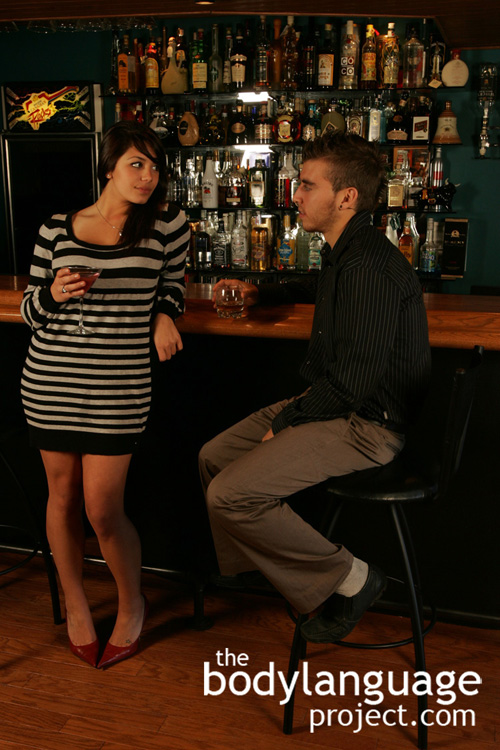
Fists into a ball is a classic expression of discomfort. The natural position for the hands is loose and relaxed, so when they ball-up, we know something is creating negative emotions. A smile, in this case, indicates stress, not happiness.
Clenching and gripping are signals of frustration and restraint. They are very different then the relaxed palm in palm gesture discussed in a previous chapter. A classic gripping posture happens when the hand opposite reaches behind the back and grabs the wrist of the opposite arm. We know it shows frustration because it serves to relieve tension through gripping, an energy displacement mechanism, and serves to show restraint because the hand is gripping the arm in effort to prevent them from striking out against another person.
Gripping, especially intensely, helps us feel more relaxed because the pain releases pleasure hormones and adrenaline. The same could be achieved through more constructive mechanisms like running, exercise, or constructing something useful, but like all forms of body language, the solutions come from an archaic part of the brain through evolution (or accident), so we are not interested in doing constructive work at a time when our minds are dealing with stress. In other words, we just want a quick, immediate fix for the anxiety, and wringing the hands helps sooth and pacifies us without having to leave the area. Most minds deal poorly with stress and can’t function normally without dealing with the source, so the last thing we want to do is leave the area in which the problem has arisen without a solution. Wringing the hands is a gesture that is seen in people the world over. At times the fingers may become interlaced appearing as if in prayer, which might even be the case. Pressure can be so great that the fingers can even blanch as blood flow is impeded.

Extreme anxiety causes the desire to control the pain by inflicting it against ourselves. It gives back our sense of control over our anxiety. People who resort to ‘cutting’ also seek to displace their anxiety and control it.
Pacing is a classic full-blown signal of anxiety, and falls into the same energy displacement category because it gives us something to do and burns extra calories in a trickle to make us feel more relaxed. Clenching and gripping are ways of signaling that a negative thought or emotion is being held back. A more intense hand gripping posture happens when the arm grips higher up near the elbow or upper arm. The higher the grip, the more frustration is present and the more self control is expressing. Clenching and gripping postures occur anytime stress and anger is present, such as waiting to see a doctor or dentist, awaiting bad news, or during conflict.
Another form of clenching that shows emotional restraint happens with the hands in a raised position instead of being hidden behind the back. This form of clenching appears as if the hands are being rung out by each other, as we would a wet article of clothing. Smiling does not negate the gesture either, and even alludes to a greater than normal tension. Smiles when accompanied by wringing, are called “stress smiles” or grimacing. The hands can be held in front of the face, resting on the desk or lap or when standing, in front of the crotch, but once again, the higher the clenching appears the more prevalent and obvious is the tension.
The hands and feet are key places to verify anxiety and will be the usual suspects in betraying emotions. They move easily and freely from the rest of the body and can be used to burn energy and release stress anxiety without requiring the body to move large distances. Because they can be moved independent of the body, they also tend to leak information more readily. Therefore, to read anxiety carefully watch for tapping toes or fingers, or feet that move frequently or never seem to find a comfortable position as well as any other repetitive behaviours. Foot movements will show more restraint than hand movements especially if someone is trying to hide their fears from others.
Clenching and gripping can have many other forms as well, including clenching the jaws tight or even talking through the teeth, cracking knuckles, pulling the hair or even plucking it, pinching one’s self, and clenching the fists by turning them into a ball. In my observations of other people, I have noticed some peculiar emotional behaviour that includes the grotesque such as squeezing pimples to plucking nose hairs to more damaging and extreme behaviours such as hitting the head and scratching called “self harm” but can include any other painful and repetitive behaviours serving to sooth emotional stress.
The more astute will notice tension from something so minor that most won’t even notice, and the carrier of which, will have no conscious awareness. That is, sitting in an awkward position, or rather, sitting in a less than fully relaxed position. This cue tells us that they won’t and can’t permit themselves to take on a more relaxed position because they should be doing something else more pressing or useful. Perhaps watching television isn’t of highest priority when one weighs the importance of a report or an essay for school, that the house needs tending to, or family time has been ignored. Notice a fully relaxed position for a person over time, and then note when they aren’t holding it, then you’ll know something isn’t right in their minds! Identify the pattern, call them out on it, and then look like a genious!




